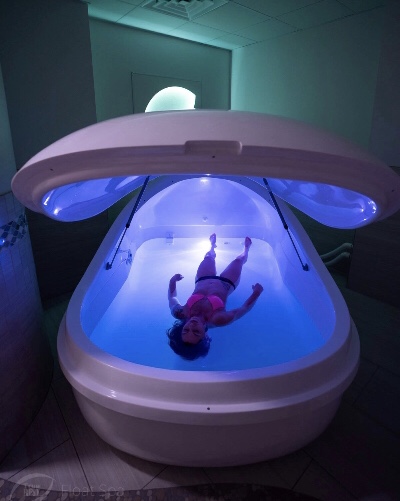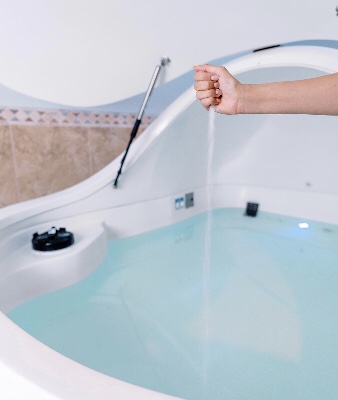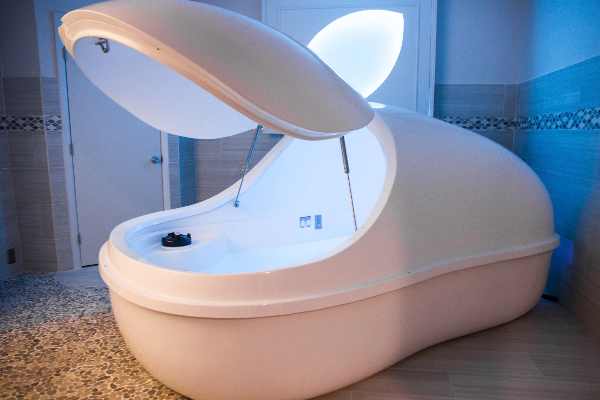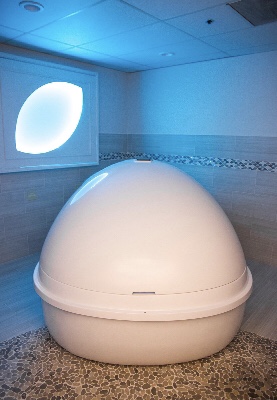BY PAM DELANY
Water has been at the heart of wellness practices for centuries, celebrated for its calming and restorative properties. Perhaps that is why people vacation by the sea, soak in hot springs, and enjoy warm baths at the end of a busy day. Water is essential to our existence, sustaining life and soothing the mind, making it a vital element of health and healing. Floatation-REST (Reduced Environmental Stimulation Therapy), or float therapy, has emerged as a holistic approach that combines the healing power of water and the practice of environmental sensory deprivation.

The origins of sensory deprivation therapy trace back to the 1950s, when neuroscientist Dr. John C. Lilly pioneered experiments in isolation tanks to study human consciousness. His work explored the effects of removing external stimuli, revealing profound impacts on mental states, creativity, and stress reduction. Although initially regarded as experimental, Lilly’s innovations laid the groundwork for modern float therapy.
Float therapy involves floating in a pod with a 30% solution of water and Epsom salts. A 180-gallon float pod requires 1,000 pounds of salt. According to True REST Float Spa, a franchised company specializing in float therapy, Epsom salts make the water so buoyant that the body floats effortlessly, creating a sensation of weightlessness while replenishing magnesium in the body. Floating is typically done without clothing to minimize tactile distractions, and the water temperature is maintained to match the skin’s surface, adding to the feeling of merging into the environment. Inside the pod, external stimuli such as light, sound, and gravity fade away, providing a unique opportunity for the body and mind to relax.

For Martha Reed, Ph.D., owner of True REST Float Spa in Glendale, Arizona, float therapy is a mission born from her own transformative experiences.
“I discovered floating during a particularly stressful period in my life, and the profound relaxation and mental clarity I achieved after just a few sessions were life-changing,” she shares. “In a float tank, you are in complete darkness and silence, with the water kept at skin temperature, which helps your mind and body reach a state of deep relaxation and meditation.”
Reed wanted to create a space for others to experience the rejuvenating effects of floating, so she opened a float spa of her own. Her clients frequently report significant relief from physical and mental conditions. Reed emphasizes that float therapy can be much more than a one-time indulgence but a practice with cumulative benefits.

“We typically recommend a series of three to five sessions for clients to experience the deeper states of relaxation and recovery fully,” she says.
The float pod’s zero-gravity environment relieves pressure on the spine and joints, making it ideal for those with chronic pain or muscle tension. Magnesium absorbed through the skin during a float session reduces inflammation, improves circulation, and supports muscle recovery. Chery Lewandowski, a customer at Reed’s spa, began floating to address neck and shoulder pain after trying chiropractic and acupuncture treatments. treatments.
“The staff has been very kind and truly go out of their way to provide a good experience,” she says, noting that small details like a spa tour and an explanation of the process made all the difference in her comfort level. Lewandowski began to notice pain reduction after three sessions and continues to float regularly to manage her pain. Float therapy’s benefits extend beyond physical health to mental health and wellness. According to Dr. Emily Choquette, a psychologist and researcher at the Laureate Institute for Brain Research, the effects of float therapy on anxiety and stress are well documented.
“The greatest body of evidence is the effect of floatation-REST on reduction of anxiety and stress in both clinical populations and healthy individuals,” she explains.
Choquette is particularly excited about its application in improving body image and assisting individuals with conditions such as anorexia nervosa.
“With regard to floatation-REST as a therapy, I am hoping the next stages of research will start to evolve into more intentional and structured applications of floatation-REST. For example, float- assisted psychotherapy is a developing area in which psychological techniques are integrated into the floatation-REST experience with the guidance of a clinician. This approach involves practicing specific therapeutic skills while floating to potentially enhance the therapeutic benefits,” she notes.
While this field is still in its infancy, the potential for integrating float therapy into mainstream medicine is promising. Reed shares this optimism, envisioning a future where healthcare practitioners recommend floatation therapy as a complementary treatment for pain management and mental health. She notes that float therapy can be particularly beneficial for individuals with PTSD. By removing external stimuli, the nervous system recognizes a safe and neutral state, allowing it to reset and renew.

“While it may still sit alongside other naturopathic options, the growing body of scientific evidence and positive patient outcomes could lead to broader acceptance and integration into conventional healthcare practices,” she says.
Despite its many benefits, some people may hesitate to try float therapy. For those concerned about feeling claustrophobic while floating, Reed points out that float tanks are spacious, and clients have full control over the environment, including the option to keep the lid open and the lights on. Some people also think they will be floating in regular salt or sodium chloride.
“In reality, we use magnesium sulfate, commonly known as Epsom salts, which not only provides buoyancy but also offers benefits like muscle relaxation and improved skin health,” she explains. Additionally, the magnesium absorbed through the skin continues to work for hours after the session, often resulting in deeply restorative sleep the same night.
Health and safety are common concerns for first-time floaters, but modern float centers like True REST take sanitation seriously. Advanced filtration systems and the antimicrobial properties of Epsom salts ensure a sanitary environment. Customers are also instructed to shower before and after floating.

Reed’s commitment to holistic wellness extends beyond floatation therapy through her work at Insights for Life, a comprehensive health and wellness center she founded.
“At Insights for Life, we offer a comprehensive range of health and wellness services designed to support holistic well-being,” she explains.
These services include massage therapy, which complements the deep relaxation achieved in float tanks, hypnotherapy, guided meditation sessions, and life coaching focused on mindfulness, stress management, and personal growth.
“Our goal is to create a holistic wellness center where clients can find the support and resources they need for their mental, physical, and emotional health,” Reed emphasizes.
At its core, wellness is about creating space to reconnect with oneself and balance mind, body, and spirit. Float therapy, along with other natural wellness practices and therapies, all contribute to this goal. In our fast-paced lives, prioritizing wellness allows us to emerge with greater clarity, resilience, and vitality. Float therapy’s impact on wellness extends beyond the pod into our overall well-being.





